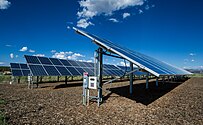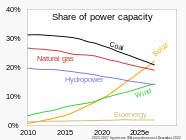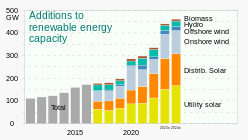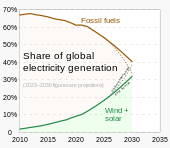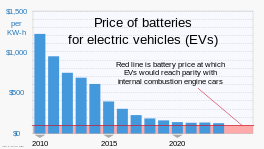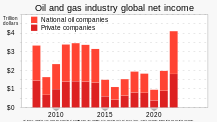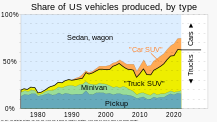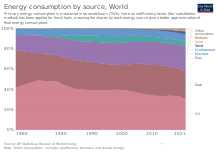Energy transition

An energy transition (or energy system transformation) is a significant structural change in an energy system regarding supply and consumption. Currently, a transition to sustainable energy (mostly renewable energy) is underway to limit climate change. It is also called renewable energy transition. The current transition is driven by a recognition that global greenhouse-gas emissions must be drastically reduced. This process involves phasing-down fossil fuels and re-developing whole systems to operate on low carbon electricity. A previous energy transition took place during the industrial revolution and involved an energy transition from wood and other biomass to coal, followed by oil and most recently natural gas.
As of 2019, 85% of the world's energy needs are met by burning fossil fuels. Energy production and consumption are responsible for 76% of annual human-caused greenhouse gas emissions as of 2018. To meet the goals of the 2015 Paris Agreement on climate change, emissions must be reduced as soon as possible and reach net-zero by mid-century. Since the late 2010s, the renewable energy transition is also driven by the rapidly increasing competitiveness of both solar and wind power. Another motivation for the transition is to limit other environmental impacts of the energy industry.
The renewable energy transition includes a shift from internal combustion engine powered vehicles to more public transport, reduced air travel and electric vehicles. Building heating is being electrified, with heat pumps as the most efficient technology by far. For electrical grid scale flexibility, energy storage and super grids are vital to allow for variable, weather-dependent technologies.
Definition
An energy transition is a broad shift in technologies and behaviours that are needed to replace one source of energy with another. A prime example is the change from a pre-industrial system relying on traditional biomass, wind, water and muscle power to an industrial system characterized by pervasive mechanization, steam power and the use of coal.
The IPCC does not define energy transition in the glossary of its Sixth Assessment Report but it does define transition as: "The process of changing from one state or condition to another in a given period of time. Transition can occur in individuals, firms, cities, regions and nations, and can be based on incremental or transformative change."
Development of the term
After the 1973 oil crisis, the term energy transition was coined by politicians and media. It was popularised by US President Jimmy Carter in his 1977 Address on the Nation on Energy, calling to "look back into history to understand our energy problem. Twice in the last several hundred years, there has been a transition in the way people use energy ... Because we are now running out of gas and oil, we must prepare quickly for a third change to strict conservation and to the renewed use of coal and to permanent renewable energy sources like solar power." The term was later globalised after the 1979 second oil shock, during the 1981 United Nations Conference on New and Renewable Sources of Energy.
From the 1990s, debates on energy transition have increasingly taken climate change mitigation into account. Since the adoption of the Paris Agreement in 2015, all 196 participating parties have agreed to reach carbon neutrality by mid-century. Parties to the agreement committed "to limit global warming to "well below 2 °C, preferably 1.5 °C compared to pre-industrial levels". This requires a rapid energy transition with a downshift of fossil fuel production to stay within the carbon emissions budget.
In this context, the term energy transition encompasses a reorientation of energy policy. This could imply a shift from centralized to distributed generation. It also includes attempts to replace overproduction and avoidable energy consumption with energy-saving measures and increased efficiency.
The historical transitions from locally-supplied wood, water and wind energies to globally supplied fossil and nuclear fuels has induced growth in end-use demand through the rapid expansion of engineering research, education and standardisation. The mechanisms for the whole-systems changes include new discipline in Transition Engineering amongst all engineering professions, entrepreneurs, researchers and educators.
Examples of past energy transitions
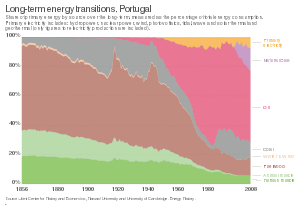
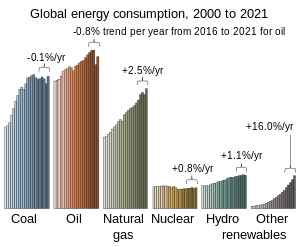
Historic approaches to past energy transitions are shaped by two main discourses. One argues that humankind experienced several energy transitions in its past, while the other suggests the term "energy additions" as better reflecting the changes in global energy supply in the last three centuries.
The chronologically first discourse was most broadly described by Vaclav Smil. It underlines the change in the energy mix of countries and the global economy. By looking at data in percentages of the primary energy source used in a given context, it paints a picture of the world's energy systems as having changed significantly over time, going from biomass to coal, to oil, and now a mix of mostly coal, oil and natural gas. Until the 1950s, the economic mechanism behind energy systems was local rather than global. Historically, there is a correlation between an increasing demand for energy and availability of different energy sources.
The second discourse was most broadly described by Jean-Baptiste Fressoz. It emphasises that the term "energy transition" was first used by politicians, not historians, to describe a goal to achieve in the future – not as a concept to analyse past trends. When looking at the sheer amount of energy being used by humankind, the picture is one of ever-increasing consumption of all the main energy sources available to humankind. For instance, the increased use of coal in the 19th century did not replace wood consumption, indeed more wood was burned. Another example is the deployment of passenger cars in the 20th century. This evolution triggered an increase in both oil consumption (to drive the car) and coal consumption (to make the steel needed for the car). In other words, according to this approach, humankind never performed a single energy transition in its history but performed several energy additions.
Contemporary energy transitions differ in terms of motivation and objectives, drivers and governance. As development progressed, different national systems became more and more integrated becoming the large, international systems seen today. Historical changes of energy systems have been extensively studied. While historical energy changes were generally protracted affairs, unfolding over many decades, this does not necessarily hold true for the present energy transition, which is unfolding under very different policy and technological conditions.
For current energy systems, many lessons can be learned from history. The need for large amounts of firewood in early industrial processes in combination with prohibitive costs for overland transportation led to a scarcity of accessible (e.g. affordable) wood, and eighteenth century glass-works "operated like a forest clearing enterprise". When Britain had to resort to coal after largely having run out of wood, the resulting fuel crisis triggered a chain of events that two centuries later culminated in the Industrial Revolution. Similarly, increased use of peat and coal were vital elements paving the way for the Dutch Golden Age, roughly spanning the entire 17th century. Another example where resource depletion triggered technological innovation and a shift to new energy sources is 19th century whaling: whale oil eventually became replaced by kerosene and other petroleum-derived products. To speed up the energy transition it is also conceivable that there will be government buyouts or bailouts of coal mining regions.
Drivers for current energy transition
A rapid energy transition to very-low or zero-carbon sources is required to mitigate the effects of climate change. Coal, oil and gas combustion account for 89% of CO2 emissions and still provide 78% of primary energy consumption.
In spite of the knowledge about the risks of climate change since the 1980s and the vanishing carbon budget for a 1.5 °C path, the global deployment of renewable energy could not catch up with the increasing energy demand for many years. Coal, oil and gas were cheaper. Only in countries with special tariffs and subsidies, wind and solar power gained a considerable share, limited to the power sector.
From 2010 to 2019, competitiveness of wind and solar power has massively increased. Unit costs of solar energy dropped sharply by 85%, wind energy by 55%, and lithium-ion batteries by 85%. This makes wind and solar power the cheapest form for new installations in many regions. Levelized costs for combined photovoltaics with storage for a few hours are already lower than for gas peaking power plants. In 2021, the new electricity generating capacity of renewables exceeded 80% of all installed power.
Another important driver is energy security and independence, with increasing importance in Europe because of the 2022 Russian invasion of Ukraine.
The deployment of renewable energy can also include co-benefits of climate change mitigation: positive socio-economic effects on employment, industrial development, health and energy access. Depending on the country and the deployment scenario, replacing coal power plants can more than double the number of jobs per average MW capacity. A study showed that converting from coal jobs to solar jobs in the U.S. would increase pay for workers by about 7%. The costs for retraining workers for the renewable energy industry was found to be trivial for both coal in the U.S. and oil sands in Canada. The latter of which would only demand 2–6% of federal, provincial, and territorial oil and gas subsidies for a single year to be reallocated to provide oil and gas workers with a new career of approximately equivalent pay. In non-electrified rural areas, the deployment of solar mini-grids can significantly improve electricity access. Employment opportunities by the green transition are associated with the use of renewable energy sources or building activity for infrastructure improvements and renovations. Additionally, the replacement of coal-based energy with renewables can lower the number of premature deaths caused by air pollution and reduce health costs. One study estimated that converting from coal to solar photovoltaics in the U.S. would decrease the number of American premature deaths by approximately 52,000.
Governments ambition to attract international support for green growth initiatives and public demand for a clean environment have been found to be drivers of the energy transition in developing countries, such as Vietnam.
Key technologies and approaches
The emissions reductions necessary to keep global warming below 2 °C will require a system-wide transformation of the way energy is produced, distributed, stored, and consumed. For a society to replace one form of energy with another, multiple technologies and behaviours in the energy system must change.
Many climate change mitigation pathways envision three main aspects of a low-carbon energy system:
- The use of low-emission energy sources to produce electricity
- Electrification – that is increased use of electricity instead of directly burning fossil fuels
- Accelerated adoption of energy efficiency measures
Renewable energy
The most important energy sources in the low carbon energy transition are wind power and solar power. They could reduce net emissions by 4 billion tons CO2 equivalent per year each, half of it with lower net lifetime costs than the reference. Other renewable energy sources include bioenergy, geothermal energy and tidal energy, but they currently have higher net lifetime costs.
By 2022, hydroelectricity is the largest source of renewable electricity in the world, providing 16% of the world's total electricity in 2019. However, because of its heavy dependence on geography and the generally high environmental and social impact of hydroelectric power plants, the growth potential of this technology is limited. Wind and solar power are considered more scalable, but still require vast quantities of land and materials. They have higher potential for growth. These sources have grown nearly exponentially in recent decades thanks to rapidly decreasing costs. In 2019, wind power supplied 5.3% worldwide electricity while solar power supplied 2.6%.
While production from most types of hydropower plants can be actively controlled, production from wind and solar power depends on the weather. Electrical grids must be extended and adjusted to avoid wastage. Dammed hydropower is a dispatchable source, while solar and wind are variable renewable energy sources. These sources require dispatchable backup generation or energy storage to provide continuous and reliable electricity. For this reason, storage technologies also play a key role in the renewable energy transition. As of 2020, the largest scale storage technology is pumped storage hydroelectricity, accounting for the great majority of energy storage capacity installed worldwide. Other important forms of energy storage are electric batteries and power to gas.
Integration of variable renewable energy sources
With the integration of renewable energy, local electricity production is becoming more variable. It has been recommended that "coupling sectors, energy storage, smart grids, demand side management, sustainable biofuels, hydrogen electrolysis and derivatives will ultimately be needed to accommodate large shares of renewables in energy systems". Fluctuations can be smoothened by combining wind and sun power and by extending electricity grids over large areas. This reduces the dependence on local weather conditions.
With highly variable prices, electricity storage and grid extension become more competitive. Researchers have found that "costs for accommodating the integration of variable renewable energy sources in electricity systems are expected to be modest until 2030". Furthermore, "it will be more challenging to supply the entire energy system with renewable energy".
Fast fluctuations increase with a high integration of wind and solar energy. They can be addressed by operating reserves. Large-scale batteries can react within seconds and are increasingly used to keep the electricity grid stable.
100% renewable energy
100% renewable energy is the goal of the use renewable resources for all energy. 100% renewable energy for electricity, heating, cooling and transport is motivated by climate change, pollution and other environmental issues, as well as economic and energy security concerns. Shifting the total global primary energy supply to renewable sources requires a transition of the energy system, since most of today's energy is derived from non-renewable fossil fuels.
Research into this topic is fairly new, with very few studies published before 2009, but has gained increasing attention in recent years. The majority of studies show that a global transition to 100% renewable energy across all sectors – power, heat, transport and industry – is feasible and economically viable. A cross-sectoral, holistic approach is seen as an important feature of 100% renewable energy systems and is based on the assumption "that the best solutions can be found only if one focuses on the synergies between the sectors" of the energy system such as electricity, heat, transport or industry.
The main barriers to the widespread implementation of large-scale renewable energy and low-carbon energy strategies are seen to be primarily social and political rather than technological or economic. According to the 2013 Post Carbon Pathways report, which reviewed many international studies, the key roadblocks are: climate change denial, the fossil fuels lobby, political inaction, unsustainable energy consumption, outdated energy infrastructure, and financial constraints.Nuclear power

In the 1970s and 1980s, nuclear power gained a large share in some countries. In France and Slovakia more than half of the electrical power is still nuclear. It is a low carbon energy source but comes with risks and increasing costs. Since the late 1990s, deployment has slowed down. Decommissioning increases as many reactors are close to the end of their lifetime. Germany stopped its last three nuclear power plants by mid April 2023. On the other hand, the China General Nuclear Power Group is aiming for 200 GW by 2035, produced by 150 additional reactors.
Economic and geopolitical aspects
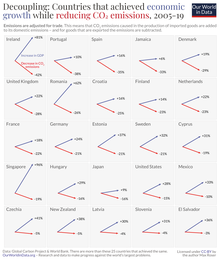
A shift in energy sources has the potential to redefine relations and dependencies between countries, stakeholders and companies. Countries or land owners with resources – fossil or renewable – face massive losses or gains depending on the development of any energy transition. In 2021, energy costs reached 13% of global gross domestic product. Global rivalries have contributed to the driving forces of the economics behind the low carbon energy transition. Technological innovations developed within a country have the potential to become an economic force.
Influences

The energy transition discussion is heavily influenced by contributions from the fossil fuel industries. One way that oil companies are able to continue their work despite growing environmental, social and economic concerns is by lobbying local and national governments.
Historically, the fossil fuel lobby has been highly successful in limiting regulations. From 1988 to 2005, Exxon Mobil, one of the largest oil companies in the world, spent nearly $16 million in anti-climate change lobbying and providing misleading information about climate change to the general public. The fossil fuel industry acquires significant support through the existing banking and investment structure. The concept that the industry should no longer be financially supported has led to the social movement known as divestment. Divestment is defined as the removal of investment capital from stocks, bonds or funds in oil, coal and gas companies for both moral and financial reasons.
Banks, investing firms, governments, universities, institutions and businesses are all being challenged with this new moral argument against their existing investments in the fossil fuel industry and many; such as Rockefeller Brothers Fund, the University of California, New York City and more; have begun making the shift to more sustainable, eco-friendly investments.
Social and environmental aspects
Impacts
A renewable energy transition can present negative social impacts for some people who rely on the existing energy economy or who are affected by mining for minerals required for the transition. This has led to calls for a just transition, which the IPCC defines as, "A set of principles, processes and practices that aim to ensure that no people, workers, places, sectors, countries or regions are left behind in the transition from a high-carbon to a low carbon economy."
Use of local energy sources may stabilise and stimulate some local economies, create opportunities for energy trade between communities, states and regions, and increase energy security.
Coal mining is economically important in some regions, and a transition to renewables would decrease its viability and could have severe impacts on the communities that rely on this business. Not only do these communities face energy poverty already, but they also face economic collapse when the coal mining businesses move elsewhere or disappear altogether. This broken system perpetuates the poverty and vulnerability that decreases the adaptive capacity of coal mining communities. Potential mitigation could include expanding the program base for vulnerable communities to assist with new training programs, opportunities for economic development and subsidies to assist with the transition.
Increasing energy prices resulting from an energy transition may negatively impact developing countries including Vietnam and Indonesia.
Increased mining for lithium, cobalt, nickel, copper, and other critical minerals needed for expansion of renewable energy infrastructure has created increased environmental conflict and environmental justice issues for some communities.
Labour
A large portion of the global workforce works directly or indirectly for the fossil fuel economy. Moreover, many other industries are currently dependent on unsustainable energy sources (such as the steel industry or cement and concrete industry). Transitioning these workforces during the rapid period of economic change requires considerable forethought and planning. The international labor movement has advocated for a just transition that addresses these concerns.
Recently, an energy crisis is upon the nations of Europe as a result of dependence on Russia's natural gas, which was cut off during the Russia-Ukraine war. This goes to show that humanity is still heavily dependent on fossil fuel energy sources and care should be taken to have a smooth transition, less energy-shortage shocks cripple the very efforts to effectively energise the transition.
Risks and barriers
Despite the widespread understanding that a transition to low carbon energy is necessary, there are a number of risks and barriers to making it more appealing than conventional energy. Low carbon energy rarely comes up as a solution beyond combating climate change, but has wider implications for food security and employment. This further supports the recognized dearth of research for clean energy innovations, which may lead to quicker transitions. Overall, the transition to renewable energy requires a shift among governments, business, and the public. Altering public bias may mitigate the risk of subsequent administrations de-transitioning – through perhaps public awareness campaigns or carbon levies.
Amongst the key issues to consider in relation to the pace of the global transition to renewables is how well individual electric companies are able to adapt to the changing reality of the power sector. For example, to date, the uptake of renewables by electric utilities has remained slow, hindered by their continued investment in fossil fuel generation capacity.
Incomplete regulations on clean energy uptake and concerns about electricity shortages have been identified as key barriers to the energy transition in coal-dependent, fast developing economies such as Vietnam.
Examples by country
From 2000–2012 coal was the source of energy with the total largest growth. The use of oil and natural gas also had considerable growth, followed by hydropower and renewable energy. Renewable energy grew at a rate faster than any other time in history during this period. The demand for nuclear energy decreased, in part due to fear mongering and inaccurate media portrayal of some nuclear disasters (Three Mile Island in 1979, Chernobyl in 1986, and Fukushima in 2011). More recently, consumption of coal has declined relative to low carbon energy. Coal dropped from about 29% of the global total primary energy consumption in 2015 to 27% in 2017, and non-hydro renewables were up to about 4% from 2%.
Asia
India
India has set renewable energy goals to transition 50% of its total energy consumption into renewable sources in the Paris climate accords. As of 2022 the Central Electricity Authority are well on track of achieving their goals, producing 160 GW electricity from clean sources like solar, wind, hydro power and nuclear power plants, this is 40% of its total capacity. India is ranked third on Ernst and Young's renewable energy country attractive index behind the USA and China.
Hydro electric power plants are a major part of India's energy infrastructure since the days of its independence in 1947. Former prime Minister Jawahar Lal Nehru called them the " temples of modern India" and believed them to be key drivers of modernity and industrialism for the nascent republic. Notable examples of hydro power stations include the 2400 MW Tehri hydropower complex, the 1960 MW Koyna hydroelectric project and the 1670 MW Srisailam Dam. Recently, India has given due importance to emerging renewable technologies like solar power plants and wind farms. They house 3 of the world's top 5 solar farms, including world's largest 2255 MW Bhadla Solar Park in and world's second-largest solar park of 2000 MW Pavgada Solar Park and 100 MW Kurnool Ultra mega solar park.
While there has been positive change, India has to cut down its reliance on traditional coal based power production as it still accounts for around 50% of its energy production. India is also moving towards its goal for electrification of the automotive industry, aiming to have at least 30% EV ownership among private vehicles by 2030.
Europe
European Union
The European Green Deal is a set of policy initiatives by the European Commission with the overarching aim of making Europe climate neutral in 2050. An impact assessed plan will also be presented to increase the EU's greenhouse gas emission reductions target for 2030 to at least 50% and towards 55% compared with 1990 levels. The plan is to review each existing law on its climate merits, and also introduce new legislation on the circular economy, building renovation, biodiversity, farming and innovation. The president of the European Commission, Ursula von der Leyen, stated that the European Green Deal would be Europe's "man on the Moon moment", as the plan would make Europe the first climate-neutral continent.
A survey found that digitally advanced companies put more money into energy-saving strategies. In the European Union, 59% of companies that have made investments in both basic and advanced technologies have also invested in energy efficiency measures, compared to only 50% of US firms in the same category. Overall, there is a significant disparity between businesses' digital profiles and investments in energy efficiency.
Germany
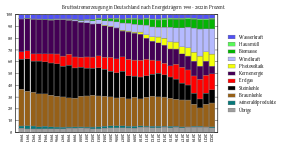
Germany has played an outsized role in the transition away from fossil fuels and nuclear power to renewables. The energy transition in Germany is known as die Energiewende (literally, "the energy turn") indicating a turn away from old fuels and technologies to new one. The key policy document outlining the Energiewende was published by the German government in September 2010, some six months before the Fukushima nuclear accident; legislative support was passed in September 2010.
The policy has been embraced by the German federal government and has resulted in a huge expansion of renewables, particularly wind power. Germany's share of renewables has increased from around 5% in 1999 to 17% in 2010, reaching close to the OECD average of 18% usage of renewables. In 2022 Germany has a share of 46,2 % and surpassed the OECD average. A large driver for this increase in the shares of renewables energy are decreases in cost of capital. Germany boasts some of the lowest cost of capitals for renewable solar and wind onshore energy worldwide. In 2021 the International Renewable Energy Agency reported capital costs of around 1.1% and 2.4% for solar and wind onshore. This constitutes a significant decrease from previous numbers in the early 2000s, where capital costs hovered around 5.1% and 4.5% respectively. This decrease in capital costs was influenced by a variety of economic and political drivers. Following the global financial crisis of 2008-2009, Germany eased the refinancing regulations on banks by giving out cheap loans with low interest rates in order to stimulate the economy again.
During this period, the industry around renewable energies also started to experience learning effects in manufacturing, project organisation as well as financing thanks to rising investment and order volumes. This coupled with various forms of subsidies contributed to a large reduction of the capital cost and the levelized cost of electricity (LCOE) for solar and onshore wind power. As the technologies have matured and become integral parts of the existing sociotechnical systems it is to be expected that in the future, experience effects and general interest rates will be key determinants for the cost-competitiveness of these technologies.
Producers have been guaranteed a fixed feed-in tariff for 20 years, guaranteeing a fixed income. Energy co-operatives have been created, and efforts were made to decentralize control and profits. The large energy companies have a disproportionately small share of the renewables market. Nuclear power stations were closed, and the existing nine stations will close earlier than necessary, in 2022.
The reduction of reliance on nuclear stations has had the consequence of increased reliance on fossil fuels. One factor that has inhibited efficient employment of new renewable energy has been the lack of an accompanying investment in power infrastructure to bring the power to market. It is believed 8300 km of power lines must be built or upgraded.
Different Länder have varying attitudes to the construction of new power lines. Industry has had their rates frozen and so the increased costs of the Energiewende have been passed on to consumers, who have had rising electricity bills. Germans in 2013 had some of the highest electricity costs in Europe. Nonetheless, for the first time in more than ten years, electricity prices for household customers fell at the beginning of 2015.
Switzerland

Due to the high share of hydroelectricity (59.6%) and nuclear power (31.7%) in electricity production, Switzerland's per capita energy-related CO2 emissions are 28% lower than the European Union average and roughly equal to those of France. On 21 May 2017, Swiss voters accepted the new Energy Act establishing the 'energy strategy 2050'. The aims of the energy strategy 2050 are: to reduce energy consumption; to increase energy efficiency; and to promote renewable energies (such as water, solar, wind and geothermal power as well as biomass fuels). The Energy Act of 2006 forbids the construction of new nuclear power plants in Switzerland.
United Kingdom
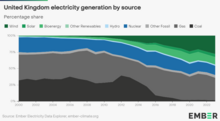
By law production of greenhouse gas emissions by the United Kingdom will be reduced to net zero by 2050. To help in reaching this statutory goal national energy policy is mainly focusing on the country's off-shore wind power and delivering new and advanced nuclear power. The increase in national renewable power – particularly from biomass – together with the 20% of electricity generated by nuclear power in the United Kingdom meant that by 2019 low carbon British electricity had overtaken that generated by fossil fuels.
In order to meet the net zero target energy networks must be strengthened. Electricity is only a part of energy in the United Kingdom, so natural gas used for industrial and residential heat and petroleum used for transport in the United Kingdom must also be replaced by either electricity or another form of low-carbon energy, such as sustainable bioenergy crops or green hydrogen.
Although the need for the energy transition is not disputed by any major political party, in 2020 there is debate about how much of the funding to try and escape the COVID-19 recession should be spent on the transition, and how many jobs could be created, for example in improving energy efficiency in British housing. Some believe that due to post-covid government debt that funding for the transition will be insufficient. Brexit may significantly affect the energy transition, but this is unclear as of 2020. The government is urging UK business to sponsor the climate change conference in 2021, possibly including energy companies but only if they have a credible short term plan for the energy transition.
See also
- Carbon bubble – Hypothesized economic bubble involving fossil-fuel energy producers
- Mobility transition – change in transport planning, and transport policy
- Nuclear power proposed as renewable energy – Ongoing debate on whether nuclear power is renewable
- Hydrogen economy – Using hydrogen to decarbonize sectors which are hard to electrify
- List of countries by renewable electricity production
- List of energy storage power plants
- List of renewable energy topics by country and territory
- Low carbon economy – Economy based on energy sources with low levels of greenhouse gas emissions
- Sustainable energy – Energy that responsibly meets social, economic, and environmental needs





